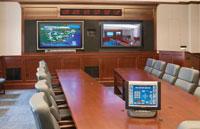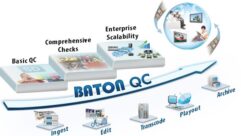

Reality Check on Videoconferencing
When times get hard, there’s always someone who says they’ve got a cure for what ails us. Gas prices high? Economy in the tank? To many, the AV solution is videoconferencing.
Is that so? Apparently, yes. “During the past 12 months, there has been an influx of customers asking about videoconferencing systems,” says Randy Rose, director of sales for Audio Video Systems (AVS) in Chantilly, Va. “Videoconferencing can be included on a project at a low cost, it’s easy to use, and there is more bandwidth available to accommodate it.”
When times get hard, there’s always someone who says they’ve got a cure for what ails us. Gas prices high? Economy in the tank? To many, the AV solution is videoconferencing. It’s going to save clients money and keep integrators in business.
Audio Video Systems installed this Tandberg-based videoconferencing system for the U.S. Interior Department.
Rising travel costs, an emphasis on employee productivity, and the recent promotion of high-definition videoconferencing by tech heavyweights like Microsoft and Cisco Systems are also spurring clients to inquire about the technology. “Videoconferencing can finally deliver what the end-user has always wanted–clear audio and video,” says Andrew Davis, managing partner at Wainhouse Research, a research firm that collects data on real-time collaboration and conferencing products and services.
Davis says that over an eight-year period between 1996 and 2003, the net percentage growth for videoconferencing was zero. Units shipped grew by 18 percent, but revenues also fell by 18 percent. “Then there was moderate growth for a few years and then blistering growth the past two years–as in, upwards of 30 percent,” he adds.
Videoconferencing manufacturers tout a channel shift that’s contributing to growth. “The shift from standard digital networks to IP networks is creating new channels for our products and opportunities for our partners,” says Randy Riebe, director of integrator channel sales for Tandberg, which recently said that telecom service providers sold 72 percent more Tandberg systems than last year. “Partners like Verizon are in the business of selling networks. As more videoconferencing systems are deployed, there is more demand for infrastructure products.”
And while videoconferencing systems were traditionally installed in corporate boardrooms, the technology is trickling down to the desktop level. “It brings the technology to the forefront,” says Riebe. “People get comfortable with it at their desk or at home and then it is expected in a conference room.”
5 Videoconferencing Sales Pitches
2. Videoconferencing offers a fast, measurable ROI. “ROI is immediate, especially in situations when there are weekly meetings where someone has to drive or get on a plane,” says Randy Rose of AVS. “Most clients can see ROI in three to six months.”
1. Videoconferencing offers quick payback. “The technology has a direct impact on cost reduction in travel,” says Tandberg’ Randy Riebe. “When used for telecommuting, it can help reduce real estate holdings by not needing a desk for every person.”
3. Videoconferencing systems offer wide deployability in an enterprise and a pleasing experience for all users. “The technology is finally delivering on the promise of five to 10 years ago. The problems of bad picture and latency are gone,” says LifeSize’s Adam Taylor.
4. Videoconferencing means faster, better communications. “Companies can use it to stay in touch with suppliers or vendors; it can have a greater impact than a phone call,” says Riebe. “We’re also seeing it expand beyond distance learning and into company training programs.”
5. Think green–and greenbacks. “Companies don’t go green to save money or make money. They usually do it for other reasons, but videoconferencing is a green technology that also makes them money,” says AVS’ Barry Goldin.
According to Rose, the increased awareness means that approximately 75 percent of AVS clients already know about videoconferencing and do not need to be educated about it. Barry Goldin, director of integration and engineering for AVS, says, “Videoconferencing is still an integration product, especially within the corporate infrastructure. Most times, the client wants videoconferencing integrated as part of a total room solution. The majority are conventional low-bandwidth systems, but there are [some] that have high-bandwidth telepresence.”
Clients also need no explanation of return on investment, which may be counterintuitive considering the economy. “In the infancy of videoconferencing, ROI was important,” says Goldin. “But the cost of the system and the infrastructure are going down. At the same time, the cost of hotel and airfare for business trips are going up.”
Looking Ahead
So is there such thing as recession-proof AV? Some say there is. “Videoconferencing is counter-cyclical to downturns like the one we’re in now,” says Adam Taylor, executive vice president of worldwide sales and service for HD videoconferencing manufacturer LifeSize, which expects growth through 2009. “We have a client that put 25 of 30 IT projects on hold for Q4, but our projects made the cut due to measurable 12- to 18-month payback.”
Most people agree videoconferencing will change the way people communicate. “Next year may be a bit of a challenge but this is a technology that adds value to the business process,” says Riebe. “Videoconferencing will become a business utility; a necessary tool for your job like a laptop or cell phone.”
Still, Goldin cautions, “The economy hasn’t really shown itself in the numbers since they are not forward-facing numbers. We are working on projects that were budgeted a year ago. I do expect that capital budgets will drop to zero in some vertical markets, but growth will continue in others, like government, medical, and education.””What we’re going to see is calmer growth,” says Davis. “Videoconferencing won’t stay at a record-breaking pace as it has in the last two years.”
Linda Seid Frembes is a freelance AV writer and a frequent contributor to Pro AV.










